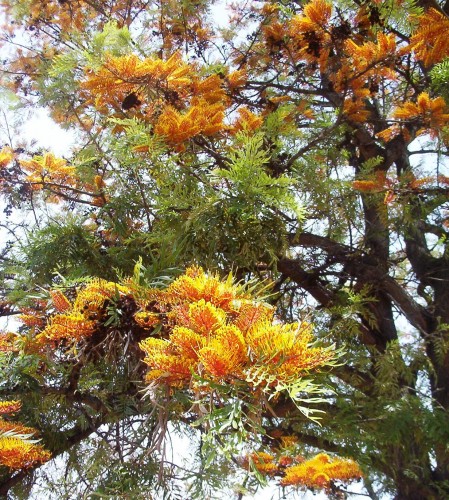Vale, Corinne Hampel
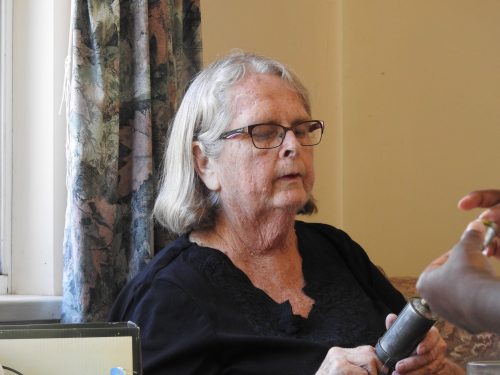
Corinne Hampel, Dec 2017
VALE, CORINNE HAMPEL
Author of this site and manager of Mallee Native Plants Nursery.
February 5th, 1950 – January 21st, 2018
Provided by her husband, Trevor Hampel.
Corinne joined the Australian Plant Society (when it was SGAP) in 1976 when she lived in Port Augusta, South Australia. She was inspired by her doctor and close friend, as well as her brother-in-law and his plantings on the family farm in the Murray Mallee. She began propagating plants for her garden in a small way.
Her passion for our native plants was further encouraged by two trips to Western Australia in the late 1970s. With the move to Murray Bridge in 1983, she began propagating plants in earnest, especially with planting up their newly acquired five-acre block. Over the next few years, this passion developed into the establishment of her Mallee Native Plants Nursery. This resulted in a keen involvement in the Adelaide plant sales which she always enjoyed. She also took plants to the annual plant sale at Geranium run by the Parrakie Group.
Both Corinne and her husband Trevor were active members of the Murray Bridge APS Group (now defunct), both of them serving terms as the group’s president. They also willingly helped in the annual Flower Show in the local town hall and organised by the local group. Both Corinne and Trevor were guest speakers on plants and birds for local clubs and service groups. This was their way of sharing another passion of theirs: photography. For some years Corinne also shared her flower photos and her passion for plants on her website.
Her love of the natural environment saw her enjoying many wanderings along bush tracks, through national parks and botanic gardens in many parts of Australia, and especially private gardens. This was always undertaken with camera and notebook in hand, and secateurs for taking cuttings when visiting private collections. She was particularly interested in our native daisies and was an active member of the Daisy Study Group. She was also an active member of the Correa Study Group, with correas being another favourite plant.
Apart from her love of plants, her other interests included a dedication to helping others through the life of her church, including leading Bible studies. She was gifted at catering for large church and community groups. She was a passionate and dedicated teacher, especially in teaching ESL learners, including recently arrived adults from overseas. She privately tutored a large number of struggling students over many years.
She was a creative person with many interests in the crafts, including sewing, patchwork quilting, pottery and spinning and weaving. She was involved for a time in the local Hand Spinners and Weavers group, and was treasurer of the local Patchwork Quilters group until a few days before her death.
In the last 8 years, much of her energy was directed towards spending time with her two grandchildren. They adored their Nanna and she shared many times of laughter and games with them; they were the delight of her life.
Corinne has always had a struggle dealing with her health issues. In her final years, this meant that her ability to maintain the nursery was slowly diminished, much to her disappointment. In the latter half of 2017, her health rapidly deteriorated and the cancer spread rapidly. Despite her often constant pain, she rarely complained and still had a positive outlook on life. She never lost interest in seeing a tree or bush in flower.
There was a rapid deterioration in her condition in the last two days of her life and she passed peacefully from this life on the 21st January 2018 just shy of her 68th birthday. She was surrounded by her immediate family who miss her dearly.
POSTSCRIPT
This site will remain open for the time being. I will maintain the site, adding the occasional post about Australian plants, flowers and their relationship with native birds. Comments will also remain open for the time being but I am generally unable to respond to questions. My knowledge of our plants and their propagation is somewhat limited, though I did learn more than most through many conversations with Corinne (and others) over the years. I also helped in her nursery from time to time. The nursery is no longer operating and there are no plants for sale.
For more advice, please contact your local plant nursery, or the relevant branch of the Australian Plant Society in your state.
Trevor Hampel
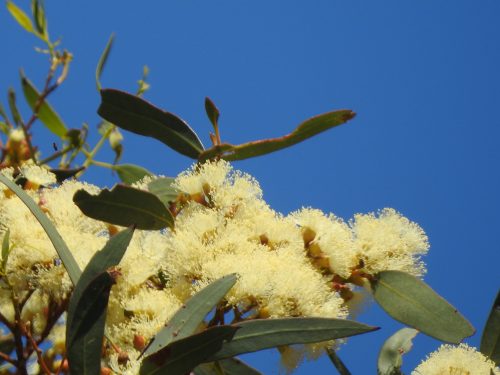
Mallee tree in flower in Corinne’s garden about the time of her death.
Spring flowers: Senecio lautus, a native daisy
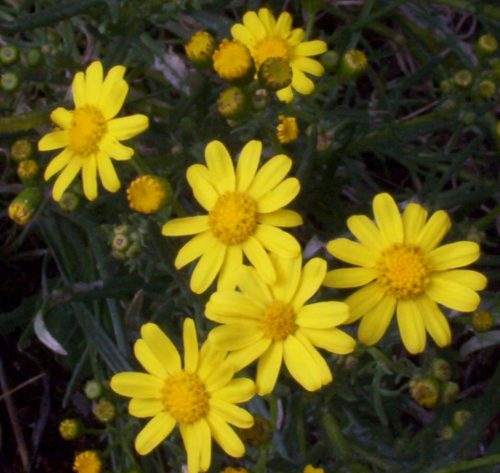
Native daisy Senecio lautus flowering in our small piece of scrub.
Why are you growing weeds? I was a bit taken a back because as far as I knew Senecio lautus was an Australian Native daisy. So what is a definition of a weed?
My understanding is that weeds:
- are introduced species from another continent, usually brought in by people knowingly or unknowingly eg. in the padding in saddles in the ‘olden days’.
- are introduced species which have become escapees from garden environments eg. watsonias and Acacia baileyana in the Adelaide Hills
- native species planted for a specific purpose which have escaped that particular environment
- native species which seed all over the place and take over garden beds. Some people don’t mind this but to others it is a nuisance and the plant is therefore a weed.
Senecio lautus may come into the latter category, but I don’t mind at all. Bring it on, I say. They flower among the mallee trees on our block, come up in pots where I don’t want them, flower prolifically along the South Eastern Freeway on the way to Adelaide and give a glorious glow of warmth on cold cloudy days.
They are easily pulled out if not wanted in a specific location. Some appear to be perennial up to 60-70cm tall, others flower at about 30cm, some require cutting back after flowering to maintain a neat bush. Many just appear to die back and re-shoot when it rains in early winter. I consider them worth having, but of course once you have one seed in the garden you are likely to have them next season whether you want them or not! Find out more about Senecio lautus.
I picked some yesterday morning in an experiment to see if they would last as a cut flower. I hadn’t bothered to try before. I will report back. One thing I did notice is that some flowers closed their petals last night.
Spring Flowering Plants
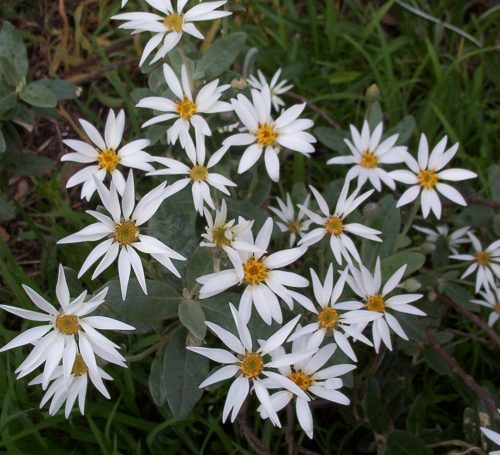
Olearia pannosa beginning to flower in my garden
When I look at the date on the last post made on this blog I am horrified but that is how life is sometimes. I have had to desist growing the large numbers of plants I used to but I cannot resist plants that have cuttings on them so I am always having a go at something, just not on the scale I would like to do.
A friend asked me for photos of a couple of South Australian native plants and that set me thinking about what I might be able to do on the blog. There are a number of posts that need tidying where links have been broken over the years, and probably better photos in my collection now. Spring is a great time to be stimulated to share the wonder of our amazing native plants as many begin to burst into flower in the next few months.
For further information Olearia pannosa.
What’s flowering in May?
There are quite a few plants flowering in my district in May. They include Swainsona formosa, Acacia iteaphylla, Eremophila maculata forms, to name a few. This has stimulated me to begin again on my blog, as well as the queries for information that I periodically receive. My lifestyle has changed and should allow me to pick up again.
Swainsona formosa may seem to be an unlikely plant to include in this list. However a roughly 5square metres front yard of a house in the town has been sown completely to the Sturt’s Desert Pea. The owner described to me that he threw a handful of seed over the yellow gravel he had spread over the area which may have been lawn before. He did it at this time of the year relying on natural rainfall to germinate the seed. He applied some extra water during the height of summer to keep them going. The result was a gorgeous display of red flowers with the black eye, against the grey green foliage. He showed me where more seed was germinating in some of the bare patches. He also had an abundance of seed pods filled with seed, a handful of which he generously gave to me.
Australian plants growing overseas.
I had the opportunity to travel to Ethiopia, and what should greet me on leaving the airport but a stand of Grevillea robusta (Silky Oak), Acacia mearnsii (Black Wattle), a Melaleuca I didn’t recognize and a Eucalyptus species. (Who would have thought I would need Ivan Holliday’s book on Melaleucas in an overseas country?) Having seen these, my eyes picked them out constantly during our stay. There were forests of Eucalypts, attempts to keep Eucalypts going as street trees, and I noticed in some local nurseries, advanced plants of Eucalypts, Acacia and Grevillea robusta. In the grounds of the place where we stayed were Callistemon (Bottlebrush) species which looked like forms of Callistemon viminalis.
It was a difficult exercise to determine what plants were the naturally occurring species in the country side of Ethiopia. There had been much clearing of vegetation, and because the naturally occurring plants were much slower growing, they were not replaced. The need for wood for fuel and building supplies compromised the revegetation programmes.
Over the years many Australian species have been propagated in foreign nurseries and proved to be popular garden and pot plants for gardeners interested in the foliage and many unusual flower forms.

